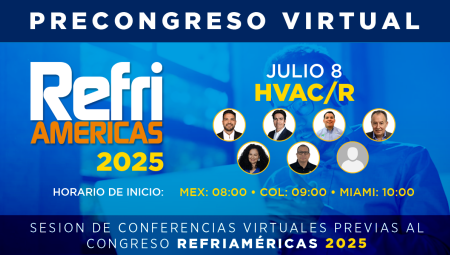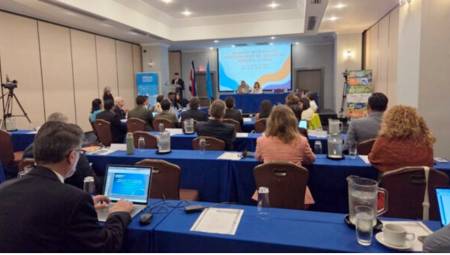by James M. Calm*
This paper reviews the evolution of refrigerants from their oldest use to the present day, and then addresses future guidelines and candidates. The article divides the story into four generations. The displacement of the first working fluids and the way in which interest in some of the first refrigerants resurfaced are also discussed; for example, renewed interest in those who currently identify as "natural." This paper also discusses an overview of current options in the contexts of existing international agreements, including the Montreal and Kyoto protocols to prevent stratospheric ozone depletion and global climate change, respectively. It also makes an assessment of environmental concerns and other local and international control measures. It also shows how isolated attention to individual environmental issues or regulatory requirements, in contrast to coordinated responses to different joint issues, can result in unexpected environmental damage that will almost certainly require future revocations.
Evolution of refrigerants
Natural cooling dates back to ancient times when stored ice, water vaporization and other evaporative processes were used. Numerous researchers in different countries studied the physics of phase change in the 1600s and 1700s; their main findings laid the groundwork for "artificial" (man-made) refrigeration. Oliver Evans initially proposed the use of a volatile fluid in a closed cycle to freeze water and turn it into ice (Evans, 1805). He also described a system that produced cooling by evaporating ether under a vacuum, and then pumped the steam to a water-cooled heat exchanger to condense and then be reused. Although there are no records that he had built a working machine, his ideas probably influenced both Jacob Perkings and Richard Trevithick. The latter proposed an air cycle system for cooling in 1828, but did not build one either. However, Perkins did with his invention of the vapor compression machine in the 1830s and thus introduced true refrigerants as we know them today. His patent describes a cycle using a "volatile fluid with the aim of producing refrigeration, freezing and condensing at the same time these fluids to put them into operation without waste being presented" (Perkins, 1834). Many refrigeration experts recognize his historic contribution to the identification of this mechanical method of vapor compression as "The Perkins Cycle." Although it was designed to use sulfuric ether (ethyl) as a refrigerant, the first tests were actually performed with caoutchoucine, an industrial solvent that Perkins used and therefore had available in his business.
Figure 1 shows the evolution of refrigerants since their advent and up to four subsequent generations.
First Generation: those that will work
The most common refrigerants during the first hundred years were familiar solvents or other volatile fluids; constituted the first generation of refrigerants "those that worked" and "those that were available". Almost all were flammable, toxic, or both, and some were also highly reactive. Accidents were common. To get a perspective, a number of companies marketed propane (R-290) as the "safe, odorless refrigerant" to promote it over ammonia (R-717) (CLPC, 1922). Historical and effective advertising indicated that propane "is a neutral chemical; therefore, there are no corrosive actions" and "it is not harmful or unpleasant, if the occasion requires it, the engineer can work on the steam without any inconvenience" (CLPC, 1922). The continued, even current, preference of ammonia over hydrocarbons in industrial applications suggests that high flammability was and remains a major concern in large systems.
The first systematic and documented search for a refrigerant that offered a practical design with improved performance came around 1920, with the examination of refrigerants for chillers (Carrier and Waterfill, 1924). Willis H. Carrier, known for his advances in psychometrics and air conditioning, and R.W. Waterfill, investigated a range of candidates for suitability in centrifugal compression (radial turbo) and positive displacement machines, with an emphasis on the development of centrifugal compression. They concluded (without analysis of the trans-critical cycles) that the performance of carbon dioxide (R-744) would depend on the cycle and the amount of liquid undercooling, but that this would lead to the lower predicted performance of the fluids analyzed. They also noted that ammonia and water (R-718) would require excessive stages for centrifugal compressors and for the observed conditions, and that water "provides low performance efficiency." They rejected sulphur dioxide (R-764) for safety reasons and carbon tetrachloride (R-10) for its incompatibility with metals, especially in the presence of water. Finally, they selected dielene (1,2-dichloroethene, R-1130) for the first centrifugal machine, although this selection required after an international search to find a source (Ingels, 1952).
Second Generation: Safety and Durability
The second generation was distinguished by a shift towards fluorochemicals for their safety and durability. Repeated leaks, from the then prevalent methyl (R-611) and sulfur dioxide (R-764) formats, delayed early efforts to commercialize refrigerators. With the instruction that "the refrigeration industry needs a new refrigerant, if they expect to get it anywhere," Thomas Midgley, Jr. and his associates Albert L. Henne and Robert R. McNary searched the entire property table to find chemicals with the desired boiling point. They restricted the search to choose those known as stable, but that were not toxic or flammable. The published boiling point for carbon tetrafluoride (R-14) directed attention to organic fluorides, but they correctly suspected that the actual boiling temperature was much lower than the published one. Returning to the periodic table of the elements, Midgley quickly eliminated those that produced insufficient volatility. It then removed those resulting in unstable and toxic compounds, as well as inert gases, based on their low boiling points. Only eight elements remained, namely carbon, nitrogen, oxygen, sulfur, hydrogen, fluorine, chlorine, and bromine (Midgley, 1937). After three days of having begun, in 1928, Midgley and his colleagues made important observations regarding the flammability and toxicity of compounds that had these elements. They also noted that each known refrigerant combined only seven of those elements at a time (all except fluorine). His first publication on fluorochemical refrigerants shows how variation in hydrocarbon chlorination and fluoridation influences boiling points, flammability, and toxicity (Midgley, 1930).
Commercial production of R-12 began in 1931, followed by R-11 in 1932 (Downing, 1966 and 1984). Chlorofluorocarbons (CFCs) and then (especially in the early 1950s in small and residential commercial air conditioners and heating pumps) hydrochlorofluorocarbons (HCFCs) dominated the second generation of refrigerants. Ammonia remained (and still is today) the most popular refrigerant in large industrial-scale systems, especially for food and beverage processing and storage.
Third Generation: Ozone Protection
The binding of released CFCs (including CFC refrigerants) for ozone depletion catalyzed the third generation with a focus on stratospheric ozone protection. The Vienna Convention and the resulting Montreal Protocol mandated an end to the use of ozone-depleting substances (ODSs). Fluorochemicals retained the first approach, with emphasis on HCFCs for transitional use and hydrofluorocarbons (HFCs) for a longer time. The changes produced renewed interest in "natural refrigerants" (particularly ammonia, carbon dioxide, hydrocarbons, and water), along with the increased use of absorption and other methods (those that do not use vapor compression systems with fluorochemical refrigerants). Public and private research programs systematically examined both additional non-fluorochemical candidates such as hydrofluoroether (HFE), but they represented few promising options.
Manufacturers marketed the first alternative refrigerants in late 1989 and, over the next 10 years, introduced replacements for most ozone-depleting substances. Non-Article 5 countries (most of them developed) phased out the use of CFC refrigerant in new equipment by 1996, as required by the Montreal Protocol. The countries included in Article 5 will do so by the year 2010. The distinction in "Article 5" relates to the level of prior use of ozone-depleting substances, as defined in the protocol. Except as restricted by national regulations, continued use and service remains permitted for existing equipment using CFC refrigerants, until otherwise removed.
The transition from HCFCs is also in process. The Montreal Protocol limits the production of HCFCs in stages in 1996, 2004, 2010, 2015 and 2020, with a total phase-out in 2030 in non-Article 5 countries, and imposes a reduction in early 2016 and the cessation of production in 2040 in the countries included in the article. Countries adopted different response methods; most central and western European countries accelerated the phase-out of HCFCs, while the other developed countries set limits, phasing out the uses of the propellant and blowing agent (especially R-141b) initially, requiring the phase-out of R-22 (the most widely used refrigerant today) by 2010, and then the ban on the use of HCFCs in new equipment by 2020. Programming for Article 5 countries begins with a freeze in 2016 and ends with phase-out by 2040. Again, future continued uses and services are allowed for existing equipment employing HCFC refrigerants, until they are otherwise retired, except as restricted by national regulations. Although already discussed here as production, the Montreal Protocol actually regulates consumption, which defines production plus imports minus exports and specified destruction. As a result, exports from Article 5 countries to non-Article 5 countries are effectively restricted to meet the demanding programs. To avoid separate domestic and export products and to exploit new technologies derived from joint ventures and licensing agreements, some products in Article 5 countries incorporate replacements earlier than required.
Three points guarantee notification. First, refrigerants historically constituted only a small fraction of total ODS emissions, but most of the same CFCs and some of the HCFCs commonly used as refrigerants were also used in many more emissive applications, including, as aerosol thrusters, foam blowing agents and solvents. Second, and at least comparable in importance to refrigerant replacements, environmental concerns inspired major changes in design, manufacturing, installation, service, and final disposal procedures to reduce avoidable emissions (Calm, 2002).
Third, the ozone layer is recovering, despite reports of ozone hole episodes in Antarctica. The size of the Antarctic hole each year results from variable factors such as south polar winds and oscillations, which induce the polar vortex, and severe winter temperatures that regulate the efficiencies of ozone destruction and natural restoration. International scientific assessments document that both new SDG releases and previous residual emissions are being reduced (WMO, 2006). Scientists interpret the trends of minimum ozone concentration and minimum ozone area shown in Figure 2 as a stabilization in recent years and the beginning of a recovery, as both measures reached their worst levels in 1998. Progress in ozone recovery is even more evident when measured through global average ozone rather than ozone in the isolated Antarctic vortex.
Although increased SDG emissions could exacerbate ozone depletion and prolong or preclude recovery, the opportunities to accelerate the recovery of the ozone layer are much more limited, especially when we consider the enormous influence of CFCs, halogens and other SDGs released in the past and which had long durations. This point suggests a focal consideration of the duration time in the atmosphere (tatm) in the selection of alternatives, to avoid a repetition of atmospheric accumulation before the discovery of new concerns that may arise in the future.
Fourth Generation: Global Warming
The successful response to ozone depletion contrasts sharply with the deteriorating situation with climate change, as shown in Figure 3. New findings and the political debate of global warming have become daily life events, especially in recent months. The Fourth Assessment Report (AR4) of the Intergovernmental Panel on Climate Change (IPCC) reflects the latest scientific consensus that states that "the warming of the climate system is unequivocal, as is currently evident by observations of increases in global average air and ocean temperatures, the great melting of snow and ice, and the rising global average sea level" (IPCC, 2007). The assessment concluded that "most of the observed increase in globally averaged temperatures since the mid-20th century is most likely due to the observed increase in anthropogenic greenhouse gas concentrations" and that "discernible human influences now extend to other aspects of climate, including ocean warming, average continental temperatures, extreme temperatures, and wind patterns" (IPCC 2007).
The Kyoto Protocol, in accordance with the International Convention on Climate Change, establishes mandatory compliance with the targets for greenhouse gas emissions, based on calculated equivalents of carbon dioxide, methane, nitrous oxide, HFCs, perflurocarbons (PFCs) and sulfur hexafluoride. It does not talk about the SDGs covered by the Montreal Protocol, although some are also very powerful GHGs. National laws and regulations to implement the Kyoto Protocol differ, but generally prohibit avoidable emissions of HFC and PFC refrigerants and, in some countries, control or impose taxes on their use. More recent measures (adopted or proposed) at the regional, national, state and municipal levels are stricter. These restrictions are forcing changes for a fourth generation of refrigerants defined by their focus on global warming. The European Parliament established the time regulation with a guideline banning fluorochemical refrigerants (Gas F) that have GWP (global warming potential) above 150 for 100-year integration into air conditioners for new model cars, effective from 2011, and for all new cars, from 2017. The adopted regulations also require periodic inspection of stationery systems using HFCs.
The EU Parliament rejected recommended measures banning HFCs such as aerosol thrusters by 2006, foam blowing agents by 2009, and refrigerants in air and refrigeration conditioners by 2010. The contentious vote on the last item was 262-368, more than 40% in favor. This significant level of support invites future reconsideration, especially with recent scientific findings regarding the onset of climate change, which is becoming faster and more severe. The immediate effect of these measurements is a ban on R-134a in its largest application and, as a refrigerant, in its largest emissive application (mobile air conditioners). The gwp limit adopted intentionally allows for consideration of low GWP HFCs (notably R152a, although flammable). The F-Gas measures also sanction stricter national regulations, some of which prohibit HFCs in large systems, explicitly prohibit the use of HFCs in chillers, or impose indirect taxes according to the GWP load on HFC refrigerants. Unions in Europe are pushing for stricter measures to restrict greenhouse gas emissions.
A number of states and cities in the United States of America have proposed restrictions on GHG emissions, either individually or regionally, although the specific impacts on individual HFCs are uncertain. California, a generally passive state with the largest population, passed legislation in late 2006 imposing a nationwide emissions chapter on utilities, refineries and manufacturing plants, with the sole goal of cutting greenhouse gas emissions and achieving those recorded in 1990 by 2020. The law requires the state regulator to determine the actual requirements, to likely include measures for refrigeration systems and car air conditioners. At least eight other states are likely to follow California's lead if it actually regulates HFC uses or emissions. A number of Northeastern and Mid-Atlantic states came together in a pact in 2007 to impose chapters on emissions from power plants and promote the commercialization of permits among utilities, and the governors of five states agreed in 2007 to the Western Regional Climate Action Initiative, with similar goals. Expect in the next edition of ACR Latin America the second part of this article
*Engineering Consultant
Email: [email protected]













